|
setSC-Darlingtonia_californica-7
|
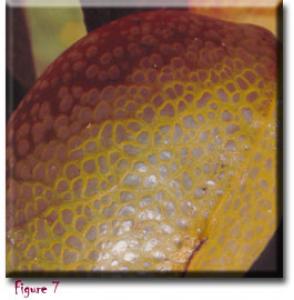
|
Here we see the windows from the outside of the hood. They are areas that have no chlorophyll or other pigments in the cells, and are remarkably clear.
|
copyright: Carlquist, BSA
license: http://images.botany.org/index.html#license |
Image
|
Carnivorous Plants

|

|
|
setSC-Darlingtonia_californica-8
|
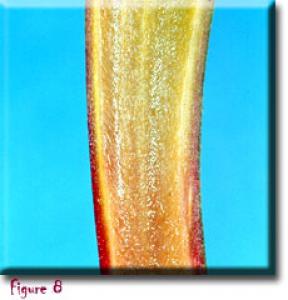
|
So why doesn't an insect just buzz around in the hood until it finds its way out through the circular opening? It is, of course, fooled by the windows. But the inside of the hood has a waxy surface, so that an insect landing on that surface can't grip it and tends to fall into the tubular part of the leaf. Once in the tubular part of the leaf, shown here in sectional view, it's in trouble. Sharp downwardly-pointing hairs, which here merely look like glistening areas, prevent the insect from climbing back up the tube to the hood.
|
copyright: Carlquist, BSA
license: http://images.botany.org/index.html#license |
Image
|
Carnivorous Plants

|

|
|
setSC-Darlingtonia_californica-9
|
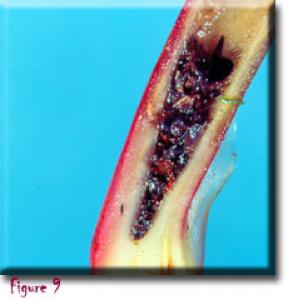
|
. ...and so the insect falls into a pool of liquid at the bottom of the tube and is drowned. The pool of liquid doesn't show here because in sectioning the leaf, the liquid drained out. But you can see the bodies of dead insects that have been trapped by this particular leaf. The soft parts of the insects are digested and turned into nitrogen compounds that are used by the plant. Darlingtonia, like other carnivorous plants, grow in water that is poor in nitrogen, and the soft parts of insects are rich in nitrogen and can supply the nutritional need to the plant. The hard surfaces of insects cannot be digested and remain in the leaf.
|
copyright: Carlquist, BSA
license: http://images.botany.org/index.html#license |
Image
|
Carnivorous Plants

|

|
|
setSC-Drosophyllum-1
|
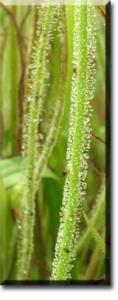
|
The leaves of Drosophyllum lusitanicum are slender, like pine needles, and bear numerous hairs, each with a sticky droplet at the tip. This gives the plant the common name, "dewy pine." It looks somewhat like a sundew, but belongs in a family by itself. The leaves don't cur up, as do those of sundews, when an insect is caught on the sticky hairs. The leaf does gradually digest insects it catches, however. Drosophyllum is native to Portugal and southern Spain.
|
copyright: Carlquist, BSA
license: http://images.botany.org/index.html#license |
Image
|
Carnivorous Plants

|

|
|
setSC-Heliamphora-5
|
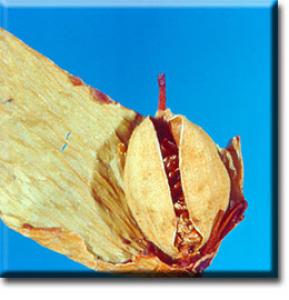
|
The fruits of Heliamphora are dry when they mature, and split open at the sides to reveal numerous seeds--botanists call such fruits capsules. The seeds probably shake out through the slits in the capsule. A stronger wind would shake out more seeds, which would be advantageous in carrying a higher proportion of the seeds for longer distances.
|
copyright: Carlquist, BSA
license: - |
Image
|
Carnivorous Plants

|

|
|
setSC-Heliamphora-6
|
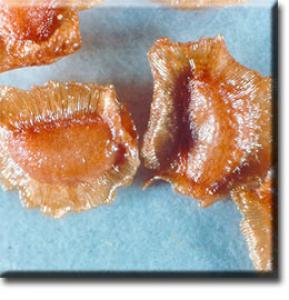
|
The seeds of Heliamphora, seen much magnified here, have wings on them. This suggests that they are dispersed by wind. The wings probably permit the seeds to be picked up by gusts of wind, once they have fallen to the ground. However, wings of this sort aren't efficient at dispersal for long distances in wind--a few seeds would be carried long distances in major storms, but in most weather conditions, many seeds would fall near the parent plant. This may be a good dispersal strategy, because the tepuis are like relatively small islands, so most of the habitats where Heliamphora could grow are very close to the existing plants. Heliamphora does not grow in the lowland areas surrounding the tepuis--the climate and other conditions are just too different from the temperature and moisture on the top of these tableland mountains.
|
copyright: Carlquist, BSA
license: http://images.botany.org/index.html#license |
Image
|
Carnivorous Plants

|

|
|
setSC-Heliamphora_heterodoxa-3
|
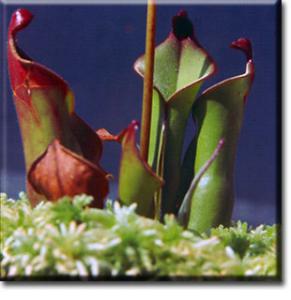
|
The leaves of Heliamphora are reportedly not very efficient at catching insects, judging from the quantity of insects found at the bottom of the tubular leaves ("pitchers"). The leaves of H. heterodoxa, shown here, show several distinct regions. The small hood-like "spoon" at the tip of a leaf has nectar glands on its lower surface. The reddish color of the spoon may attract insects, and the hood-like shape might prevent nectar from being washed away by rain--these are only guesses. The funnel-like zone of the leaf below the spoon tends to be reddish and therefore an insect might follow that color cue. The lower neck-like part of the funnel has downwardly-pointing hairs that insure that an insect will continue to walk downward, since walking upward against these tiny spikes would be difficult. The lower part of the leaf, a little wider than the base of the funnel, contains water with a digestive enzyme, a pool from which an insect, once caught, rarely escapes. The leaf seems like a well-designed trap. If the number of insects caught is fewer than in leaves of Darlingtonia and Sarracenia, perhaps that reflects a relatively low insect density in the relatively high elevations of the tepuis.
|
copyright: Carlquist, BSA
license: http://images.botany.org/index.html#license |
Image
|
Carnivorous Plants

|

|
|
setSC-Heliamphora_heterodoxa-4
|
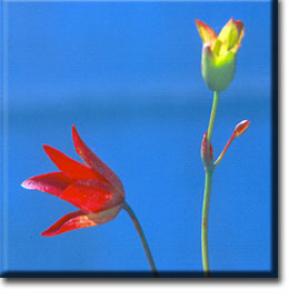
|
The sepals of Heliamphora heterodoxa are easily seen and vary from green to red in color--the petals are small and can't be seen in this picture. The flowers tend to become upright as the fruits mature.
|
copyright: Carlquist, BSA
license: Http://images.botany.org/index.html#license |
Image
|
Carnivorous Plants

|

|
|
setSC-Heliamphora_minor-1
|
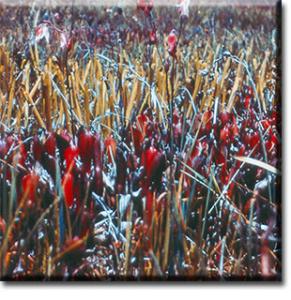
|
Heliamphora is one of three genera of the family Sarraceniaceae (the others are Darlingtonia and Sarracenia). One interesting fact about Heliamphora is the area where it grows: the flat-topped mountains (called "tepuis") of what is collectively called the Guiana Highlands. These mountains, which average about 2400 m tall, rise rather sharply to flat summit areas that are often cloud covered. Heliamphora can be found in wet, boggy areas of the tepuis. This picture shows Heliamphora minor on Chimanta-Tepui.
|
copyright: Carlquist, BSA
license: http://images.botany.org/index.html#license |
Image
|
Carnivorous Plants

|

|
|
setSC-Heliamphora_tatei-2
|
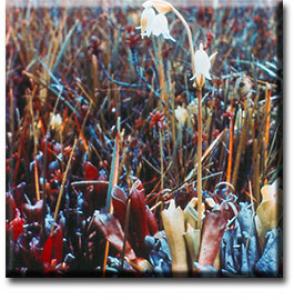
|
There are six species of Heliamphora on the tepuis. Five of the species, like H. minor (shown), tend to have short stems, but one, H. tatei, tends to climb or lean on other plants and reaches 4 m in height. According to DNA data, Heliamphora is most like the ancestor of the family Sarraceniaceae. The flowers are recurved, as in Darlingtonia and Sarracenia. Recurved flowers have been claimed to be an adaptation for keeping rain from collecting in flowers, and thus pollination could occur even during rainy periods.
|
copyright: Carlquist, BSA
license: http://images.botany.org/index.html#license |
Image
|
Carnivorous Plants

|

|
|
setSC-Helosis-1
|
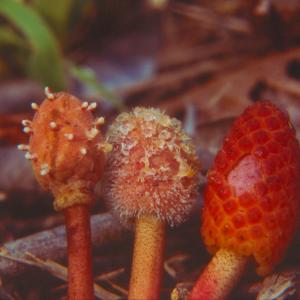
|
Helosis may look like a fungus, but it's a flowering plant with very tiny flowers. It grows as a parasite on the roots of trees, forming a mound of tissue from which emerge flower stalks (inflorescences). Helosis is native to tropical America, but the family to which it belongs, Balanophoraceae, occurs in tropical areas around the globe. Here are three flowering stalks of Helosis. The one at the right is covered with polygonal scales that fall off. The one at left shows an inflorescence bearing male flowers, which are white and well separated from each other the inflorescence in the middle shows the dense covering of extremely tiny white female flowers.
Return to the Helosis page or the Parasitic Plant Index.
|
copyright: Carlquist, BSA
license: http://images.botany.org/index.html#license |
Image
|
Parasitic Plants

|

|
|
setSC-Helosis-2
|
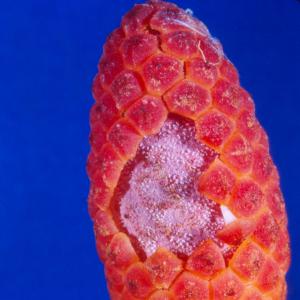
|
The orange-colored polygonal scales of the inflorescence of this Helosis (found near Iquitos, Peru) are beginning to fall off. Revealed underneath are tiny white dots--female flowers. They are among the smallest flowers, if not the smallest flowers, of any flowering plant in the world.
Return to the Helosis page or the Parasitic Plant Index.
|
copyright: Carlquist, BSA
license: http://images.botany.org/index.html#license |
Image
|
Parasitic Plants

|

|
|
setSC-Helosis-3
|
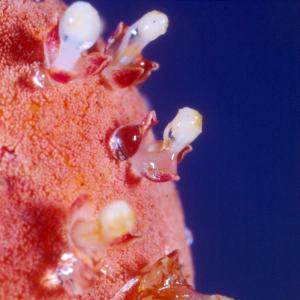
|
Here are the male flowers of the Helosis from Iquitos, Peru. Each flower has three petals (or what appear to be petals) surrounding a group of three united stamens. Filling the male flowers are droplets of sweet liquid. Flies are attracted to these drops. In the process of feeding on the liquid, the flies pick up pollen grains, which they transfer to female flowers.
Return to the Helosis page or the Parasitic Plant Index.
|
copyright: Carlquist, BSA
license: http://images.botany.org/index.html#license |
Image
|
Parasitic Plants

|

|
|
setSC-Helosis-4
|

|
A Helosis (Balanophoraceae) from Costa Rica. Here are three flowering stalks (inflorencescences) of this species. The one at left is young, covered with polygonal structures that will fall off to reveal the flowers. The large inflorescence in the middle is covered with male flowers, some of which (white) are falling off. The inflorescence at right is covered with female flowers, which are much smaller than the male flowers. If you look closely, you will see a fly visiting the inflorescence in the middle, feeding on the sweet shiny droplets that occur on the male flowers.
Return to the Helosis page or the Parasitic Plant Index.
|
copyright: Carlquist, BSA
license: http://images.botany.org/index.html#license |
Image
|
Parasitic Plants

|

|
|
setSC-Helosis-5
|
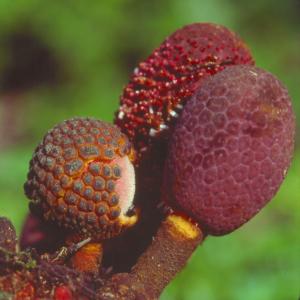
|
Inflorescence of the Costa Rican Helosis. From right to left: an inflorescence still covered by polygonal scales; an inflorescence in which male flowers are beginning to emerge; and an inflorescence from which some scales have fallen, revealing a covering of female flowers. The top of the plant body from which the flowering stalks have emerged is at lower left; it connects with the root of a tree (not shown).
Return to the Helosis page or the Parasitic Plant Index.
|
copyright: Carlquist, BSA
license: http://images.botany.org/index.html#license |
Image
|
Parasitic Plants

|

|
|
setSC-Helosis-6
|
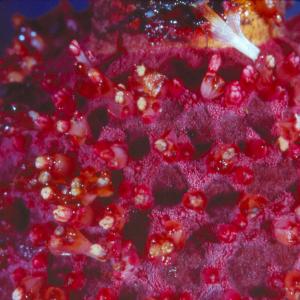
|
The surface of an inflorescence of a Costa Rican Helosis, showing male flowers among the polygonal scales that have shrunken away from each other. The male flowers are reddish and bear white-tipped stamens. A male flower pulled away and shown on its side is at upper right: two petals diverge, and the stamens are in its center.
Return to the Helosis page or the Parasitic Plant Index.
|
copyright: Carlquist, BSA
license: http://images.botany.org/index.html#license |
Image
|
Parasitic Plants

|

|
|
setSC-Helosis-7
|
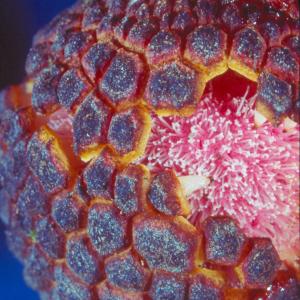
|
The purplish-black scales are falling from the inflorescence of this Costa Rican Helosis, revealing the numerous female flowers underneath. The tips of the female flowers are white.
Return to the Helosis page or the Parasitic Plant Index.
|
copyright: Carlquist, BSA
license: http://images.botany.org/index.html#license |
Image
|
Parasitic Plants

|

|
|
setSC-Helosis-8
|
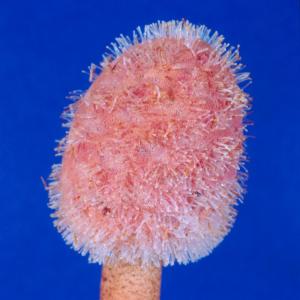
|
Hundreds of female flowers cover this flowering stalk of a Costa Rican Helosis. Although no moisture is shown here, droplets of liquid are often found on female Helosis flowers, attracting flies, which also visit the male flowers in search of a similar liquid.
Return to the Helosis page or the Parasitic Plant Index.
|
copyright: Carlquist, BSA
license: http://images.botany.org/index.html#license |
Image
|
Parasitic Plants

|

|
|
setSC-Hemitomes_congestum-1
|
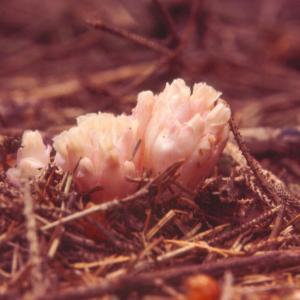
|
Hemitomes congestum, the so-called Gnome Plant, is one of the rarest of the monotropoids--the group that includes Indian Pipe and the Snow Plant. You're lucky to see Hemitomes. It's rare, and it's small-only three or four cm tall when in flower. Sometimes it's pale pink in color.
Return to the Hemitomes congestum page or the Parasitic Plant Index.
|
copyright: Carlquist, BSA
license: http://images.botany.org/index.html#license |
Image
|
Parasitic Plants

|

|
|
setSC-Hemitomes_congestum-10
|
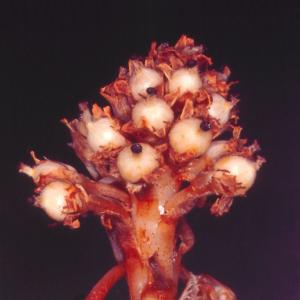
|
The fruits of Hemitomes congestum are round, white, and fleshy. Because the fruits are fleshy at maturity, presumably they are eaten by some animal which thereby scatters the seeds in various places in the forest litter. But nobody knows what animal eats the fruits.
Return to the Hemitomes congestum page or the Parasitic Plant Index.
|
copyright: Carlquist, BSA
license: http://images.botany.org/index.html#license |
Image
|
Parasitic Plants

|

|